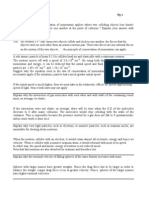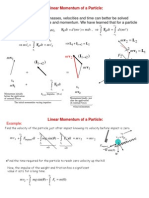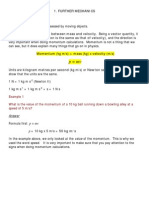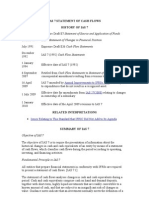CH 7
Uploaded by
Rodel FadroganeCH 7
Uploaded by
Rodel Fadrogane1
Ch7. Impulse and Momentum
There are situations in which force acting on an
object is not constant, but varies with time.
Two new ideas: Impulse of
the force and Linear
momentum of an object.
2
Impulse-Momentum Theorem
3
Definition of Impulse
The impulse J of a force is the product of the
average force and the time interval
during which the force acts:
F
t
J =
F
t
Impulse is a vector quantity and has the same
direction as the average force.
SI Unit of Impulse: newton
.
second (N
.
s)
4
Definition of Linear Momentum:
The linear momentum p of an object is the
product of the objects mass m and velocity v:
p=mv
Linear momentum is a vector quantity that
points in the same direction as the velocity.
SI Unit of Linear Momentum:
kilogram
.
meter/second(kg
.
m/s)
5
t
v v
a
t
a m F
t
mv mv
t
v v
m F
t t 0 0
) (
6
Impulse-Momentum Theorem
When a net force acts on an object,
the impulse of this force is equal to
the change in momentum of the
object:
0
) ( mv mv t F
f
Impulse
Final
momentum
Initial
momentum
Impulse=Change in momentum
7
Example 1. A Well-Hit Ball
A baseball (m=0.14kg) has initial velocity of v
0
=-38m/s
as it approaches a bat. The bat applies an average
force that is much larger than the weight of the
ball, and the ball departs from the bat with a final
velocity of v
f
=+58m.
(a) Determine the impulse applied to the ball by the bat.
(b) Assuming time of contact is =1.6
*
10
-3
s, find the
average force exerted on the ball by the bat.
F
t
8
0
mv mv J
f
) / 38 )( 14 . 0 ( ) / 58 )( 14 . 0 ( s m kg s m kg
N
s
s m kg
t
J
F 8400
10 6 . 1
/ . 4 . 13
3
+
= +13.4 kg.m/s
(a)
(b)
9
Example 2. A Rain Storm
Rain comes straight down with velocity of v
0
=-15m/s
and hits the roof of a car perpendicularly. Mass of
rain per second that strikes the car roof is 0.06kg/s.
Assuming the rain comes
to rest upon striking the
car (v
f
=0m/s), find the
average force exerted by
the raindrop.
10
0
0
) ( v
t
m
t
mv mv
F
f
F
= -(0.06kg/s)(-15m/s)=0.9 N
According to action-reaction law, the force
exerted on the roof also has a magnitude of
0.9 N points downward: -0.9N
11
Conceptual Example 3.
Hailstones Versus Raindrops
Suppose hail is falling. The hail comes straight
down at a mass rate of m/ =0.06kg/s and an
initial velocity of v
0
=15m/s and strikes the roof
perpendicularly. Hailstones bounces off the roof.
t
Would the force on the
roof be smaller than,
equal to, or greater than
that in example 2?
Greater.
12
Check your understanding 1
Suppose you are standing on the edge of a dock and jump
straight down. If you land on sand your stopping time is much
shorter than if you land on water. Using the impulse-
momentum theorem as a guide, determine which one is correct.
A In bringing you to a halt, the sand exerts a greater impulse on
you than does the water.
B In bringing you to a halt, the sand and the water exert the
same impulse on you, but the sand exerts a greater average
force.
C In bringing you to a halt, the sand and the water exert the
same impulse on you, but the sand exerts a smaller average
force.
B
13
The Principle of Conservation of
Linear Momentum
14
Two types of forces act on the system:
1. Internal forces: Forces that the objects within
the system exert on each other.
2. External forces: Forces exerted on the objects by
agents external to the system.
01 1 1 1
12
1
) ( v m v m t F W
f
+
02 2 2 2
21
2
) ( v m v m t F W
f
+
External
force
External
force
Internal
force
Internal
force
15
) ( ) ( ) (
02 2 01 1 2 2 1 1
21 12
2 1
v m v m v m v m t F F W W
f f
+ + + + +
= p
f
- p
0
(Sum of average external
forces)
t = p
f
- p
0
Then 0 = p
f
- p
0
or
p
f
=
p
0
m
1
v
f1
+m
2
v
f2
= m
1
v
01
+m
2
v
02
p
f
p
0
sum of average
external forces
sum of average
internal forces
t
( )
+
internal forces cancel F
12
= -F
21
If sum of external forces is zero (an isolated system)
16
Principle of Conservation of Linear Momentum:
The total linear momentum of an isolated system remains
constant(is conserved). An isolated system is one for which
the vector sum of the average external forces acting on the
system is zero.
17
Conceptual Example 4.
Is the Total Momentum
Conserved?
Two balls collide on the billiard table
that is free of friction.
(a) Is the total momentum of the two
ball system the same before and after
the collision?
(b) Answer (a) for a system that contains
only one ball.
(a) The total momentum is conserved.
(b) The total momentum of one ball
system is not conserved.
18
Example 5.
Assembling a Freight Train
Car 1 has a mass of m
1
=65
*
10
3
kg and moves at a
velocity of v
01
=+0.8m/s. Car 2 has a mass of
m
2
=92
*
10
3
kg and a velocity of v
02
=+1.3m/s.
Neglecting friction, find the common velocity v
f
of the cars after they become coupled.
19
(m
1
+m
2
) v
f
= m
1
v
01
+ m
2
v
02
After collision Before collision
2 1
02 2 01 1
m m
v m v m
v
f
+
+
) 10 92 10 65 (
) / 3 . 1 )( 10 92 ( ) / 8 . 0 )( 10 65 (
3 3
3 3
kg kg
s m kg s m kg
+
+
=+1.1 m/s
20
Example 6. Ice Skaters
Starting from rest, two skaters
push off against each other on
smooth level ice (friction is
negligible). One is a woman
(m
1
=54kg), and one is a
man(m
2
=88kg). The woman
moves away with a velocity of
v
f1
=2.5m/s. Find the recoil
velocity v
f2
of the man.
21
For the two skater system, what are the forces?
In horizontal direction
F
12
F
21
internal forces
system taken together 0
No external forces. isolated system
conservation of momentum
22
s m
kg
s m kg
m
v m
v
f
f
/ 5 . 1
88
) / 5 . 2 )( 54 (
2
1 1
2
m
1
v
f1
+ m
2
v
f2
= 0
after pushing before pushing
It is important to realize that the total linear
momentum may be conserved even when the kinetic
energies of the individual parts of a system change.
23
Check your understanding 2
A canoe with two people aboard is coasting with an initial
momentum of 110kg.m/s. Then person 1 dives off the back of
the canoe. During this time, the net average external force
acting on the system is zero. The table lists four possibilities
for the final momentum of person 1 and final momentum of
person 2 plus the canoe, immediately after person 1 leaves the
canoe. Which possibility is correct?
Person 1
Person 2 & canoe
a -60kg.m/s +170kg.m/s
b -30kg.m/s +110kg.m/s
c -40kg.m/s -70kg.m/s
d +80kg.m/s -30kg.m/s
a
24
Collisions in One Dimension
Elastic collision: One in which the total kinetic
energy of the system after the collision is equal to
the total kinetic energy before the collision.
Inelastic collision: One in which the total kinetic
energy of the system is not the same before and
after the collision; if the objects stick together
after colliding, the collision is said to be
completely inelastic.
25
Example 7.
A Collision in One Dimension
A ball of mass m
1
=0.25kg
and velocity v
01
=5m/s
collides head-on with a ball
of mass m
2
=0.8kg that is
initially at rest(v
02
=0m/s).
No external forces act on
the balls. If the collision in
elastic, what are the
velocities of the balls after
the collision?
26
0
01 1 2 2 1 1
+ + v m v m v m
f f
Total momentum
after collision
Total momentum
before collision
0
2
1
2
1
2
1
2
01 1
2
2 2
2
1 1
+ + v m v m v m
f f
Total kinetic energy
after collision
Total kinetic energy
before collision
1
2 01 1
2
1
m
v m v m
v
f
f
(1)
(3)
(2)
27
Substitute in (2)
2
0 1
2
2
2
1
2 0 1
1
1 2
2 1
2
1
2
1
2
1
v m v m
m
v m v m
m
f
f
+
,
_
2
0 1
1
2
1 2
1
0 2 1
2 2
2
2
0
2
1
1
2 2 1 2 1
2
1
2
1
2
2
1
v m
m
v m m
m
v v m m v m v m
f f f
+
+
0
2
2
2 2 2
1
0 2 1
2
1
2 1
2
2
2
0 1
1
2
0
2
1
2 1
2
1 1
,
_
+
+
m
v v m m
v
m
m m m
v m
m
v m
f
f
28
( )
2 1 2
0
1
2 1
2
2 1
1
2
2
2
2
f f
v v
m
m m
v m m
m
m
+
( )
2 1 2
0 1
2
1 2
2
f f
v v m v m m +
1 2
0
2 1
1
2
v
m m
m
v
f
+
29
Substitute in (1)
2 1 1
2 0 1 1 f f
v m v m v m
1 1
0
2 1
1
2 0 1
2
v
m m
m
m v m
+
1
0
2 1
2
1
2
1 v
m m
m
m
,
_
+
30
1 1
0
2 1
2 2 1
1 1
2
v
m m
m m m
m v m
f 1
]
1
+
+
1 1
0
2 1
2 1
v
m m
m m
v
f 1
]
1
31
m
1
=0.25, m
2
=0.8
v
01
=5 m/s, v
02
= 0
s m v
f
/ 62 . 2 5
8 . 0 25 . 0
8 . 0 25 . 0
1
,
_
s m v
f
/ 38 . 2 5
8 . 0 25 . 0
25 . 0 2
2
+
32
Types of Collisions
33
Example 8.
A Ballistic Pendulum
The ballistic pendulum consists
of a block of wood(mass
m
2
=2.5kg)suspended by a wire
of negligible mass. A
bullet(mass m
1
=0.01kg)is fired
with a speed v
01
. After collision,
the block has a speed v
f
and
then swings to a maximum
height of 0.65m above the initial
position. Find the speed v
01
of
the bullet, assuming air
resistance is negligible.
34
Is conservation of energy valid?
No (completely inelastic)
Is conservation of momentum valid?
Yes (no external forces )
Just before
collision
Just after
collision
m
1
+m
2
v
f
35
01 1 2 1
) ( v m v m m
f
+
Total momentum
after collision
Total momentum
before collision
f
v
m
m m
v
1
2 1
01
+
36
Applying conservation of energy
2
2 1 2 1
) (
2
1
) (
f f
v m m gh m m + +
Total mechanical energy at
top of swing, all potential
Total mechanical energy at
bottom of swing, all kinetic
v
f
h
f
=0.65 m
37
s m/ 896 +
38
Check your understanding 3
Two balls collide in a one-dimensional, elastic
collision. The two balls constitute a system,
and the net external force acting on them is
zero. The table shows four possible sets of
values for the initial and final momenta of the
two balls as well as their initial and final
kinetic energies. Which one is correct?
39
Initial Final
Momentum Kinetic
Energy
Momentum Kinetic
Energy
a Ball 1 +4 kg.m/s 12 J -5 kg.m/s 10 J
Ball 2 -3 kg.m/s 5 J -1 kg.m/s 7 J
b Ball 1 +7 kg.m/s 22 J +5 kg.m/s 18 J
Ball 2 +2 kg.m/s 8 J +4 kg.m/s 15 J
c Ball 1 -5 kg.m/s 12 J -6 kg.m/s 15 J
Ball 2 -8 kg.m/s 31 J -9 kg.m/s 25 J
d Ball 1 +9 kg.m/s 25 J +6 kg.m/s 18 J
Ball 2 +4 kg.m/s 15 J +7 kg.m/s 22 J
d
40
Example 9.
A Collision in Two Dimensions
41
Collisions in Two Dimensions
v
f2
=0.7
m/s
Ball 1
m
1
=0.15 kg
Ball 2
m
2
=0.26 kg
before after before after
v
01
sin50= v
f1
cos 0 v
02
v
f2
cos35
-v
01
cos50= v
f1
sin 0 0 -v
f2
sin35
x component
y component
42
x component
y component
x x x f x f
v m v m v m v m
02 2 01 1 2 2 1 1
+ +
y y y f y f
v m v m v m v m
02 2 01 1 2 2 2 1
+ +
P
fx
P
0x
P
fy
P
0y
43
Use momentum conservation to determine the
magnitude and direction of the final velocity of ball 1
after the collision.
x component
) 0 . 35 )(cos / 700 . 0 )( 260 . 0 ( ) )( 15 . 0 (
0
1
s m kg v kg
x f
+
) / 540 . 0 )( 260 . 0 ( ) 0 . 50 )(sin / 900 . 0 )( 150 . 0 (
0
s m kg s m kg +
Ball 1 after
Ball 2 after
Ball 1 before
Ball 2 before
44
y component
)] 0 . 35 )(sin / 700 . 0 ( )[ 260 . 0 ( ) )( 150 . 0 (
0
1
s m kg v kg
y f
+
0 )] 0 . 50 )(cos / 900 . 0 ( )[ 150 . 0 (
0
+ s m kg
Ball 1 after Ball 2 after
Ball 1 before Ball 2 before
45
s m s m s m v
f
/ 64 . 0 ) / 12 . 0 ( ) / 63 . 0 (
2 2
1
+
0 1
11 )
/ 63 . 0
/ 12 . 0
( tan
s m
s m
46
Center of Mass
2 1
2 2 1 1
m m
x m x m
x
cm
+
+
47
Suppose m
1
=5kg, m
2
=12kg
x
1
=2m, x
2
=6m
m
kg kg
m kg m kg
x
cm
8 . 4
12 0 . 5
) 0 . 6 )( 12 ( ) 0 . 2 )( 0 . 5 (
+
+
48
2 1
2 2 1 1
m m
x m x m
x
cm
+
+
2 1
2 2 1 1
m m
v m v m
v
cm
+
+
During a time displacements of the
particles, displacement of cm
T
1
x
2
x
cm
x
49
s m
kg kg
s m kg s m kg
v
cm
/ 19 . 1
800 . 0 250 . 0
) / 0 )( 800 . 0 ( ) / 00 . 5 )( 250 . 0 (
+
+
+ +
s m
kg kg
s m kg s m kg
v
cm
/ 19 . 1
800 . 0 250 . 0
) / 38 . 2 )( 800 . 0 ( ) / 62 . 2 )( 250 . 0 (
+
+
+ +
Before collision
After collision
m
1
=0.25 kg, m
2
=0.8 kg
v
01
=5 m/s, v
02
=0 m/s
50
Check your understanding 4
Water, dripping at a constant rate from a faucet,
falls to the ground. At any instant, there are many
drops in the air between the faucet and the
ground. Where does the center of mass of the
drops lie relative to the halfway point between the
faucet and the ground: above it, below it, or
exactly at the halfway point?
Above the halfway point
(consider gravity)
51
Concepts & Calculations Example 10.
A Scalar and a Vector
52
Jim and Tom are both running at a speed of
4m/s. Jim has a mass of 90kg, and Tom
has a mass of 55kg. Find the kinetic energy
and momentum of the two-jogger system
when
(a) Jim and Tom are both running due north.
(b)Jim is running due north and Tom is
running due south.
53
2 2
2
1
2
1
Tom Tom Jim Jim system
v m v m KE +
J s m kg s m kg 1160 ) / 00 . 4 )( 0 . 55 (
2
1
) / 00 . 4 )( 0 . 90 (
2
1
2 2
+
Tom Tom Jim Jim system
v m v m P +
s m kg s m kg s m kg / 580 ) / 00 . 4 )( 0 . 55 ( ) / 00 . 4 )( 0 . 90 ( + + +
(a)
54
(b)
2 2
2
1
2
1
Tom Tom Jim Jim system
v m v m KE +
J s m kg s m kg 1160 ) / 00 . 4 )( 0 . 55 (
2
1
) / 00 . 4 )( 0 . 90 (
2
1
2 2
+
Tom Tom Jim Jim system
v m v m P +
s m kg s m kg s m kg / 140 ) / 00 . 4 )( 0 . 55 ( ) / 00 . 4 )( 0 . 90 ( + +
55
Concepts & Calculations Example 11.
Momentum and Kinetic Energy
Mass Speed
Object A 2.0 kg 6.0 m/s
Object B 6.0 kg 2.0 m/s
Find the magnitude of the momentum and
the kinetic energy for each object.
56
s m kg s m kg v m P
A A A
/ 12 ) / 0 . 6 )( 0 . 2 (
s m kg s m kg v m P
B B B
/ 12 ) / 0 . 2 )( 0 . 6 (
J s m kg v m KE
A A A
36 ) / 0 . 6 )( 0 . 2 (
2
1
2
1
2
2
J s m kg v m KE
B B B
12 ) / 0 . 2 )( 0 . 6 (
2
1
2
1
2
2
57
Problem 6
REASONING The impulse that the roof of the car
applies to the hailstones can be found from the impulse-
momentum theorem, Equation 7.4. Two forces act on the
hailstones, the average force exerted by the roof, and
the weight of the hailstones. Since it is assumed that is
much greater than the weight of the hailstones, the net
average force is equal to .
F
( )
F
F
F
SOLUTION From Equation 7.4, the impulse that the
roof applies to the hailstones is:
{ {
( )
Impulse
Final Initial
momentum momentum
t m m m
f 0 f 0
F v v v v
123
58
Solving for (with up taken to be the positive direction) gives
F
[ ]
( ) (0.060 kg/s) ( 15 m/s) ( 15 m/s) = +1.8 N
m
t
_
+
,
f 0
F v v
This is the average force exerted on the hailstones by the roof
of the car. The positive sign indicates that this force points
upward. From Newton's third law, the average force exerted
by the hailstones on the roof is equal in magnitude and
opposite in direction to this force. Therefore,
Force on roof = -1.8 N
The negative sign indicates that this force points downward.
59
Problem 20
REASONING During the time that the skaters are pushing
against each other, the sum of the external forces acting on
the two-skater system is zero, because the weight of each
skater is balanced by a corresponding normal force and
friction is negligible. The skaters constitute an isolated
system, so the principle of conservation of linear momentum
applies. We will use this principle to find an expression for
the ratio of the skaters masses in terms of their recoil
velocities. We will then obtain expressions for the recoil
velocities by noting that each skater, after pushing off, comes
to rest in a certain distance. The recoil velocity, acceleration,
and distance are related by Equation 2.9 of the equations of
kinematics.
60
Ignore kinetic friction
Skater 1 glides twice as far as skater 2
Conservation of momentum
Initial momentum = final momentum
2 2 1 1
0
f f
v m v m +
1
2
2
1
f
f
v
v
m
m
61
v
f1
and v
f2
are just after pushing each other. That will be the
initial velocity for the motion of the skaters and will come to
rest.
v
f1
v
f2
x
2
x
1
V
end
=0 V
end
=0
stop
a
1
a
2
For skater 1
ax v v
i f
2
2 2
+
1 1
2
1
2
2 x a v v
f end
+
1 1
2 2
1
2 x a v v
end f
1 1
2 0 x a
62
For skater 2
ax v v
i f
2
2 2
+
2 2
2
2
2
2 x a v v
f end
+
2 2
2
2
2 x a v
f
Magnitude of the acceleration is the same, i.e.,
2 1
a a
63
If x
1
is positive, x
2
is negative,
1 2
a a
2 1
2 ) ( x x ( 1 glides twice as far as 2 )
1 1
2
1
2 x a v
f
1 1
1
1
2
2
)
2
)( ( 2 x a
x
a v
f
707 . 0
2
1
2
1 1
1 1
2
1
x a
x a
m
m
(opposite
direction)
64
Problem 34
REASONING AND SOLUTION
Momentum is conserved in the
horizontal direction during the
"collision." Let the coal be
object 1 and the car be object 2.
Then
2 2 1 1 2 1
0 . 25 cos ) ( v m v m v m m
f
+ +
2 1
2 2 1 1
25 cos
m m
v m v m
v
f
+
+
s m
kg kg
s m kg s m kg
/ 56 . 0
440 150
) / 5 . 0 )( 440 ( 25 cos ) / 8 . 0 )( 150 (
+
+
The direction of the final velocity is to the right.
v
f
65
Problem 39
REASONING The two balls
constitute the system. The tension in
the wire is the only non-conservative
force that acts on the ball. The tension
does no work since it is perpendicular
to the displacement of the ball.
Since W
nc
=0 J, the principle of conservation of mechanical
energy holds and can be used to find the speed of the 1.50-kg ball
just before the collision. Momentum is conserved during the
collision, so the principle of conservation of momentum can be
used to find the velocities of both balls just after the collision.
Once the collision has occurred, energy conservation can be used
to determine how high each ball rises.
66
SOLUTION
a. Applying the principle of energy conservation to the
1.50-kg ball, we have
1
2
2 1
2
2
0
mv mgh
E
mv mgh
E
f f
f
0 0
+ +
If we measure the heights from the lowest point in the
swing, h
f
=0 m, and the expression above simplifies to
1
2
2
1
2
2
mv mv mgh
f 0 0
+
Solving for v
f
, we have
v v g h
f 0 0
2 2
( m/ s ) 2 ( 9 . 8 0 m / s ) ( 0 . 3 0 0 m )5 . 5 6 m/ s + +
2
2 5 0 0 .
h
0
=
m
1
=
m
2
=
v
0
=
h
f
=0, v
f
=?
67
Just before
Just after
m
1
m
2
v
01 v
02
v
f1
v
f2
Conservation of momentum
2 2 1 1 02 2 01 1 f f
v m v m v m v m + +
) 0 (
02
v
68
Conservation of energy
2
2 2
2
1 1
2
02 2
2
01 1
) (
2
1
) (
2
1
) (
2
1
) (
2
1
f f
v m v m v m v m + +
2
2 2
2
1 1
2
01 1
) (
2
1
) (
2
1
) (
2
1
f f
v m v m v m +
01
2 1
2 1
1
) ( v
m m
m m
v
f
+
01
2 1
1
2
)
2
( v
m m
m
v
f
+
69
b. If we assume that the collision is elastic, then the
velocities of both balls just after the collision can be obtained
from Equations 7.8a and 7.8b:
01
2 1
2 1
1
v
m m
m m
v
f
,
_
01
2 1
1
2
2
v
m m
m
v
f
,
_
and
Since v
01
corresponds to the speed of the 1.50-kg ball just
before the collision, it is equal to the quantity v
f
calculated
in part (a). With the given values of and
,and the value of obtained in part (a),
Equations 7.8a and 7.8b yield the following values:
m
1
1.50 kg
m
2
kg 4 60 . v
01
= 5.56 m/ s
The minus sign in v
f1
indicates that the first ball reverses its
direction as a result of the collision.
v
f1
= -2.83 m/s
70
c. If we apply the conservation of mechanical energy to
either ball after the collision we have
1
2
2 1
2
2
0
mv mgh
E
mv mgh
E
f f
f
0 0
+ +
where v
0
is the speed of the ball just after the collision, and h
f
is the final height to which the ball rises. For either ball, h
0
= 0
m, and when either ball has reached its maximum height,
v
f
=0 m/s. Therefore, the expression of energy conservation
reduces to
gh v h
v
g
f 0 f
0
or
1
2
2
2
2
71
Thus, the heights to which each ball rises after the collision are
1.50- kg ball
(2.83 m/ s)
(9.80 m/ s
0.409 m
f
0
2
2
h
v
g
2
2 2 )
4.60- kg ball
(2.73 m/ s)
(9.80 m/ s
0.380 m
f
0
2
2
h
v
g
2
2 2 )
72
Problem 41
REASONING AND SOLUTION The location of the center
of mass for a two-body system is given by Equation 7.10:
1 1 2 2
cm
1 2
m x m x
x
m m
+
+
73
where the subscripts "1" and "2" refer to the earth and the moon,
respectively. For convenience, we will let the center of the earth be
coincident with the origin so that and , the center-to-
center distance between the earth and the moon. Direct calculation
then gives
x
1
0
x d
2
22 8
6 2
cm
24 22
1 2
(7.35 10 kg)(3.85 10 m)
4.67 10 m
5.98 10 kg 7.35 10 kg
m d
x
m m
+
+
74
Problem 50
REASONING AND SOLUTION
F F
a. According to Equation 7.4, the impulse-momentum
theorem, . Since the only horizontal force
exerted on the puck is the force exerted by the goalie
. Since the goalie catches the puck, . Solving
for the average force exerted on the puck, we have
( )
t m m
f 0
F v v
F
0 m/s
f
v
-2.2
*
10
3
N
75
By Newtons third law, the force exerted on the goalie by the
puck is equal in magnitude and opposite in direction to the
force exerted on the puck by the goalie. Thus, the average
force exerted on the goalie is 2.2
*
10
3
N
b. If, instead of catching the puck, the goalie slaps it with his
stick and returns the puck straight back to the player with a
velocity of 65 m/s, then the average force exerted on the puck
by the goalie is
= -4.4
*
10
3
N
-3
76
The average force exerted on the goalie by the puck
is thus +4.4
*
10
3
N.
The answer in part (b) is twice that in part (a). This
is consistent with the conclusion of Conceptual
Example 3. The change in the momentum of the puck
is greater when the puck rebounds from the stick.
Thus, the puck exerts a greater impulse, and hence a
greater force, on the goalie.
You might also like
- Chapter 7 Powerpoint 1225339266570076 9No ratings yetChapter 7 Powerpoint 1225339266570076 924 pages
- CH 15 Kinetics of Particles Impulse and MomentumNo ratings yetCH 15 Kinetics of Particles Impulse and Momentum24 pages
- SMK Tat Beng Physics Form 4 2.4 Linear MomentumNo ratings yetSMK Tat Beng Physics Form 4 2.4 Linear Momentum41 pages
- Section A Physics Paper 1 Mechanics Revision Questions For A Level With AnswersNo ratings yetSection A Physics Paper 1 Mechanics Revision Questions For A Level With Answers120 pages
- A 3-kg Object Experiences An Accel'n of 4 M/S/S.: CollisionsNo ratings yetA 3-kg Object Experiences An Accel'n of 4 M/S/S.: Collisions6 pages
- Mechanics For Systems of Particles and Extended BodiesNo ratings yetMechanics For Systems of Particles and Extended Bodies19 pages
- DC Pandey Mechanics Part 1 Chap 08 Solution100% (1)DC Pandey Mechanics Part 1 Chap 08 Solution43 pages
- Notes05 - Applications of Newtion's LawsNo ratings yetNotes05 - Applications of Newtion's Laws44 pages
- DR Raudhah Ahmadi KNS1633 Engineering Mechanics Civil Engineering, UNIMASNo ratings yetDR Raudhah Ahmadi KNS1633 Engineering Mechanics Civil Engineering, UNIMAS32 pages
- Student Solutions Manual to Accompany Economic Dynamics in Discrete Time, secondeditionFrom EverandStudent Solutions Manual to Accompany Economic Dynamics in Discrete Time, secondedition4.5/5 (2)
- 2016 NRCC ELC 01 E ElectricalPowerDistributionNo ratings yet2016 NRCC ELC 01 E ElectricalPowerDistribution1 page
- Topic 3: SANITARY PIPEWORK - Piping SystemNo ratings yetTopic 3: SANITARY PIPEWORK - Piping System16 pages
- Brief Re: Appeal of Talley Evidence SuppressionNo ratings yetBrief Re: Appeal of Talley Evidence Suppression54 pages
- Gen - Math Simple and Compound Interests NOPRAYERNo ratings yetGen - Math Simple and Compound Interests NOPRAYER45 pages
- Powerpoint Anti-Bullying Act in The Philippines89% (57)Powerpoint Anti-Bullying Act in The Philippines47 pages
- Decision-Making in The EIA Process: EIA Training Resource Manual Topic 10 Slide 1No ratings yetDecision-Making in The EIA Process: EIA Training Resource Manual Topic 10 Slide 112 pages
- How Much Force Is Needed by The Man To Push The Car? Can A Man Pushes The Car?No ratings yetHow Much Force Is Needed by The Man To Push The Car? Can A Man Pushes The Car?19 pages
- THE WESTERN UNION COMPANY $250,000,000 6.200% Notes Due 2040No ratings yetTHE WESTERN UNION COMPANY $250,000,000 6.200% Notes Due 20402 pages
- J. Duncan Glover, Mulukutla S. Sarma, Thomas Overbye - Power System Analysis and Design, Fifth Edition - Cengage Learning (2011) - 273-306No ratings yetJ. Duncan Glover, Mulukutla S. Sarma, Thomas Overbye - Power System Analysis and Design, Fifth Edition - Cengage Learning (2011) - 273-30634 pages
- Press Release - MyHSR Corp To Launch Project Delivery Partner (PDP) Tender For The KL-SG HSR ProjectNo ratings yetPress Release - MyHSR Corp To Launch Project Delivery Partner (PDP) Tender For The KL-SG HSR Project2 pages
- Petitioner Philippine Geothermal Production Company, Inc. (PGPCI) v. Commissioner of Internal RevenueNo ratings yetPetitioner Philippine Geothermal Production Company, Inc. (PGPCI) v. Commissioner of Internal Revenue2 pages
- I Choose The Best Answer A, B, C or D To Complete Each Gap in The Following SentencesNo ratings yetI Choose The Best Answer A, B, C or D To Complete Each Gap in The Following Sentences12 pages
- Lessons From The Life of Abu Dharr (May Allah Be Pleased With HimNo ratings yetLessons From The Life of Abu Dharr (May Allah Be Pleased With Him8 pages
- ACCT5001 2022 S2 - Module 3 - Lecture Slides StudentNo ratings yetACCT5001 2022 S2 - Module 3 - Lecture Slides Student33 pages
- Baral, John Carlo, Anga, SPLEFLEASPDXS9HWLWOJ PDFNo ratings yetBaral, John Carlo, Anga, SPLEFLEASPDXS9HWLWOJ PDF2 pages
- Brown-Araneta v. Araneta, 9 October 2013, G.R. No. 190814No ratings yetBrown-Araneta v. Araneta, 9 October 2013, G.R. No. 1908143 pages
- Physics: Laminated QuickStudy Reference GuideFrom EverandPhysics: Laminated QuickStudy Reference Guide
- Section A Physics Paper 1 Mechanics Revision Questions For A Level With AnswersSection A Physics Paper 1 Mechanics Revision Questions For A Level With Answers
- A 3-kg Object Experiences An Accel'n of 4 M/S/S.: CollisionsA 3-kg Object Experiences An Accel'n of 4 M/S/S.: Collisions
- Mechanics For Systems of Particles and Extended BodiesMechanics For Systems of Particles and Extended Bodies
- DR Raudhah Ahmadi KNS1633 Engineering Mechanics Civil Engineering, UNIMASDR Raudhah Ahmadi KNS1633 Engineering Mechanics Civil Engineering, UNIMAS
- Exercises of Kinematics, Dynamics and StaticsFrom EverandExercises of Kinematics, Dynamics and Statics
- O level Physics Questions And Answer Practice Papers 2From EverandO level Physics Questions And Answer Practice Papers 2
- Simple Definition And Explanation Of Force In PhysicsFrom EverandSimple Definition And Explanation Of Force In Physics
- A Complete Course in Physics (Graphs) - First EditionFrom EverandA Complete Course in Physics (Graphs) - First Edition
- Student Solutions Manual to Accompany Economic Dynamics in Discrete Time, secondeditionFrom EverandStudent Solutions Manual to Accompany Economic Dynamics in Discrete Time, secondedition
- Decision-Making in The EIA Process: EIA Training Resource Manual Topic 10 Slide 1Decision-Making in The EIA Process: EIA Training Resource Manual Topic 10 Slide 1
- How Much Force Is Needed by The Man To Push The Car? Can A Man Pushes The Car?How Much Force Is Needed by The Man To Push The Car? Can A Man Pushes The Car?
- THE WESTERN UNION COMPANY $250,000,000 6.200% Notes Due 2040THE WESTERN UNION COMPANY $250,000,000 6.200% Notes Due 2040
- J. Duncan Glover, Mulukutla S. Sarma, Thomas Overbye - Power System Analysis and Design, Fifth Edition - Cengage Learning (2011) - 273-306J. Duncan Glover, Mulukutla S. Sarma, Thomas Overbye - Power System Analysis and Design, Fifth Edition - Cengage Learning (2011) - 273-306
- Press Release - MyHSR Corp To Launch Project Delivery Partner (PDP) Tender For The KL-SG HSR ProjectPress Release - MyHSR Corp To Launch Project Delivery Partner (PDP) Tender For The KL-SG HSR Project
- Petitioner Philippine Geothermal Production Company, Inc. (PGPCI) v. Commissioner of Internal RevenuePetitioner Philippine Geothermal Production Company, Inc. (PGPCI) v. Commissioner of Internal Revenue
- I Choose The Best Answer A, B, C or D To Complete Each Gap in The Following SentencesI Choose The Best Answer A, B, C or D To Complete Each Gap in The Following Sentences
- Lessons From The Life of Abu Dharr (May Allah Be Pleased With HimLessons From The Life of Abu Dharr (May Allah Be Pleased With Him
- ACCT5001 2022 S2 - Module 3 - Lecture Slides StudentACCT5001 2022 S2 - Module 3 - Lecture Slides Student
- Brown-Araneta v. Araneta, 9 October 2013, G.R. No. 190814Brown-Araneta v. Araneta, 9 October 2013, G.R. No. 190814
































































































